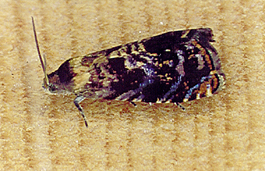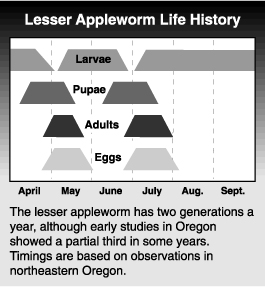by Harold R. Moffitt and Michael J. Willett, originally published 1993
Grapholitha prunivora (Walsh) (Lepidoptera: Tortricidae)
The lesser appleworm is an internal fruit feeder, similar to codling moth and oriental fruit moth. It is a relatively obscure pest of several deciduous trees in the United States and Canada and is not commonly found in commercial orchards. It became a concern in the Pacific Northwest in the early 1990s as a quarantine issue on apples for export, particularly to Japan, but has not been a production problem for the grower.
The insect is native to northeastern North America and was first reported as a pest in the Pacific Northwest in the late 1940s when it infested prunes, plums and cherries in the Milton-Freewater area of Oregon. It was not then a problem on apricot, peach, pear or apple. Within a short time, the insect was no longer considered a pest, perhaps due to the introduction of more effective pesticides in commercial orchards. Surveys by the Washington State Department of Agriculture and the U.S. Department of Agriculture in the early 1990s indicated that the insect may be distributed throughout the fruit-producing areas of Washington and Oregon. However, it is not an economic pest in orchards.
Hosts
The lesser appleworm prefers fruits of plants in the rose family. Hawthorn is its principal host. Before apple and other deciduous fruits were introduced to North America, it probably infested the fruits of hawthorn, native plums and crab apples, shadbush, wild cherry and wild rose. Since then its host range has widened to include apple, European plum and prune, and cherry. There are also reports that it has been reared from fruits of Christmas berry (toyon), from woody tissue of galls of black knot disease of plum, and from insect galls on elm and oak leaves.
Life stages
Egg
The egg closely resembles a small codling moth egg. It is a flat, oval disk about 1/40 inch (0.75 mm) long. When first laid, it is shiny white and slightly opaque. As it matures, it turns yellowish white and develops a red ring inside. Just before it hatches, the dark head capsule of the developing larva is visible.
Larva

The newly hatched larva is creamy white with a black or dark brown head capsule and is about 1/20 inch (1 mm) long. The mature larva is pinkish white and measures up to 3/8 inch (9 mm) long. It is difficult to distinguish from other larvae that might be found in the same host fruits, particularly oriental fruit moth. The larva of the lesser appleworm can be distinguished from the codling moth larva by an anal comb, which the codling moth larva does not have.
Pupa
The pupa is golden brown and about 1/5 inch (5 mm) long.
Adult
The adult lesser appleworm is a small moth, about 1/4 inch (5 to 6 mm) long. The body color is dark brown to almost black. Its main distinguishing characteristic is a pattern of white, grayish orange, and golden brown with iridescent light blue bands on the forewings.
Life history
The lesser appleworm overwinters as a mature larva in debris on the ground under the host plant or under bark scales on the tree. In the Pacific Northwest, the pupa develops over a 2- to 3-week period in early spring. Adult emergence begins in early April, depending on weather conditions, and adults that develop from overwintering larvae may be active until early June.
 Soon after emerging, adults mate and females lay eggs on leaf surfaces or fruit. Eggs hatch in 7 to 10 days. Larvae feed on the fruit immediately after hatching and continue to feed for 18 to 24 days. When mature, they spin tightly woven cocoons in debris or fruit on the ground or under bark scales on the tree.
Soon after emerging, adults mate and females lay eggs on leaf surfaces or fruit. Eggs hatch in 7 to 10 days. Larvae feed on the fruit immediately after hatching and continue to feed for 18 to 24 days. When mature, they spin tightly woven cocoons in debris or fruit on the ground or under bark scales on the tree.
Second generation adults are active from mid-June through early August. Moths from this generation tend to deposit more of their eggs on fruit than on leaves. After maturing, the larvae spin cocoons and most overwinter. In some years, a third flight of adults may occur.
Damage
The larvae feed inside the fruit, most often entering through the calyx end.
Monitoring
If monitoring for lesser appleworm is required, several commercially available pheromone traps are effective, but routine monitoring for control purposes is unnecessary.
Biological control
Little is known about predators or parasitoids of the lesser appleworm.
Management
As this insect is not an economic pest, control is not necessary.
